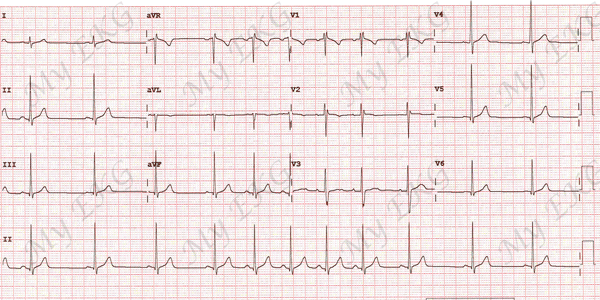Sinus Arrhythmia
Sinus arrhythmia is a common finding in the electrocardiogram of children and young, healthy people.
Sinus arrhythmia is a normal physiological phenomenon and it is considered a variation of normal sinus rhythm.
It is defined as an irregularity in the rate of normal sinus rhythm. Its main characteristic on the EKG is a variation in the P-P intervals greater than 0.12 s with a normal P wave morphology 1 2.
Minor variation in the P-P intervals may be present in most subjects, but the differences between the longest and shortest intervals usually do not exceed 0.12 s 1.
Types of Sinus Arrhythmia
There are three types of sinus arrhythmia.
- Respiratory sinus arrhythmia.
- Nonrespiratory sinus arrhythmia.
- Ventriculophasic sinus arrhythmia.
All three types of of sinus arrhythmia are seen more commonly when the heart rate is slow 1.
Respiratory Sinus Arrhythmia

Respiratory sinus arrhythmia:
Variation in P-P intervals related to the respiratory cycle.
Respiratory sinus arrhythmia is the more common type, in this arrhythmia the variation in heart rate is related to the respiratory cycle 1 2 3.
Inspiration increases the heart rate by decreasing vagal tone, during expiration vagal tone is restored, leading to a decrease in heart rate.
The variation is attributed to changes in vagal tone as a result of reflex mechanisms arising from the pulmonary and systemic vascular systems during respiration 1.
The respiratory sinus arrhythmia is a normal phenomenon that is usually prevalent in infants and children and tends to decrease with age.
Nonrespiratory Sinus Arrhythmia
Nonrespiratory sinus arrhythmia is more common in elderly people in association with underlying heart disease, although the arrhythmia is not a marker for structural heart disease 1 2 3.
The mechanism is unknown, but in some cases the sinus arrhythmia may be a manifestation of sinus node dysfunction 1.
It may also be present present in patients with an increase in intracranial pressure 1.
Ventriculophasic Sinus Arrhythmia
Ventriculophasic sinus arrhythmia typically occurs in patients with sinus rhythm and complete AV block 1 2 3.
In a complete AV block, differences may occur between P-P intervals containing a QRS complex and intervals not containing a QRS.
The P-P interval containing the QRS complex is shorter than the P-P interval not containing the QRS complex.
Changes in intracardiac pressure and volume, and in stroke volume are probably responsible for the changes in the sinus cycle mediated by the carotid baroreceptor 1 2 3.
Ventriculophasic sinus arrhythmia is not a pathological arrhythmia.
Treatment:
Sinus arrhythmia, especially respiratory sinus arrhythmia, is a common finding in the EKG. It is considered to be a normal variation of sinus rhythm. Upon confirming the diagnosis, there are no further recommendations regarding treatment 2.
Differential diagnosis for sinus arrhythmia would include premature sinus or atrial complexes, sick sinus syndrome (sinoatrial block or sinus pauses), atrial fibrillation, or complete AV block 1 2 3.
References
- 1. Surawicz B, Knilans TK. Chou’s electrocardiography in clinical practice, 6th ed. Philadelphia: Elservier; 2008.
- 2. Soos MP, McComb D. Sinus Arrhythmia. [Updated 2020 Jan 28]. In: StatPearls [Internet]. Treasure Island (FL): StatPearls Publishing; 2020 Jan-. Available from: https://www.ncbi.nlm.nih.gov/books/NBK537011/.
- 3. Issa ZF, Miller JM, Zipes DP. Sinus Node Dysfunction. in Clinical Arrhythmology and Electrophysiology: A Companion to Braunwald's Heart Disease. Second Edition. W.B. Saunders; 2012, p. 164-174. doi: 10.1016/B978-1-4557-1274-8.00008-7.
If you Like it... Share it.






